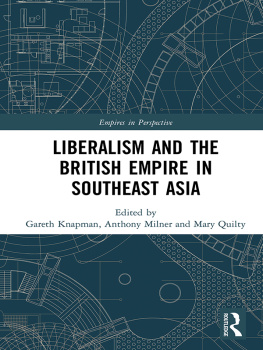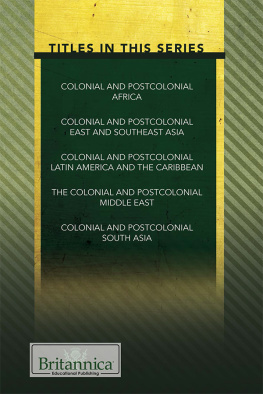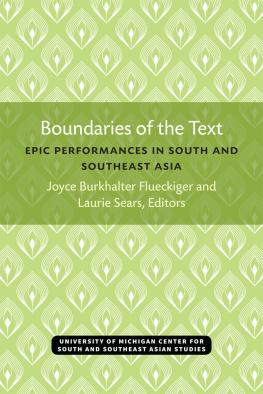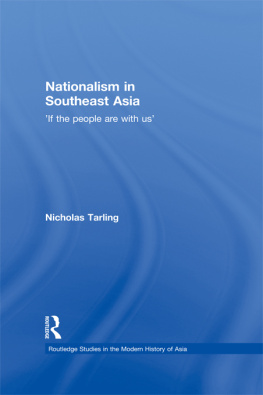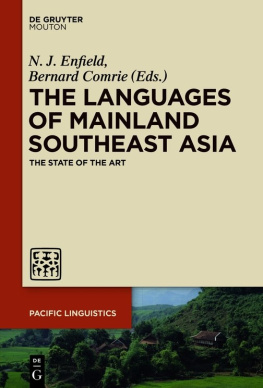ROUTLEDGE LIBRARY EDITIONS: BUSINESS AND ECONOMICS IN ASIA
Volume 30
STATE, MARKET AND PEASANT IN COLONIAL SOUTH AND SOUTHEAST ASIA
First published in 1998 by Ashgate Publishing Limited
This edition first published in 2019
by Routledge
2 Park Square, Milton Park, Abingdon, Oxon OX14 4RN
and by Routledge
52 Vanderbilt Avenue, New York, NY 10017
Routledge is an imprint of the Taylor & Francis Group, an informa business
1998 Michael Adas
All rights reserved. No part of this book may be reprinted or reproduced or utilised in any form or by any electronic, mechanical, or other means, now known or hereafter invented, including photocopying and recording, or in any information storage or retrieval system, without permission in writing from the publishers.
Trademark notice: Product or corporate names may be trademarks or registered trademarks, and are used only for identification and explanation without intent to infringe.
British Library Cataloguing in Publication Data
A catalogue record for this book is available from the British Library
ISBN: 978-1-138-48274-6 (Set)
ISBN: 978-0-429-42825-8 (Set) (ebk)
ISBN: 978-1-138-61820-6 (Volume 30) (hbk)
ISBN: 978-0-429-46130-9 (Volume 30) (ebk)
Publishers Note
The publisher has gone to great lengths to ensure the quality of this reprint but points out that some imperfections in the original copies may be apparent.
Disclaimer
The publisher has made every effort to trace copyright holders and would welcome correspondence from those they have been unable to trace.
This edition copyright 1998 by Michael Adas.
Published in the Variorum Collected Studies Series by
Ashgate Publishing Limited
Gower House, Croft Road,
Aldershot, Hampshire GU11 3HR
Great Britain
Ashgate Publishing Company
Old Post Road,
Brookfield, Vermont 050369704
USA
ISBN 086078696X
British Library CIP Data
Adas, Michael
State, Market and Peasant in Colonial South and Southeast Asia.
(Variorum Collected Studies Series: CS616)
1. Peasantry South Asia. 2. Peasantry South Asia History.
3. Peasantry Asia, Southeastern. 4. Peasantry Asia, Southeastern
History. 5. Colonies Asia History. 6. South Asia Civilization
Foreign Influences. 7. Asia, Southeastern Civilization Foreign
Influences. I. Title
305.56330954
US Library of Congress CIP Data
Adas, Michael
State, Market and Peasant in Colonial South and Southeast Asia / Michael Adas
p. cm. (Variorum Collected Studies Series: CS616).
1. Peasant Uprisings Asia History. 2. Peasant Uprisings Asia,
Southeastern History. 3. Peasantry Asia History. 4. Peasantry
Asia, Southeastern History. I. Title. II. Series: Variorum Collected
Studies: CS 616.
HD 1536.8.A33 1998 9819002
305.563300959dc21 CIP
The paper used in this publication meets the minimum requirements of the American National Standard for Information Sciences Permanence of Printed by Galliard (Printers) Ltd, Great Yarmouth, Norfolk, Great Britain Paper for Printed Library Materials, ANSI Z39.481984.

Printed by Galliard (Printers) Ltd, Great Yarmounth, Norfolk, Great Britain
VARIORUM COLLECTED STUDIES SERIES CS616
PUBLISHERS NOTE
The articles in this volume, as in all others in the Collected Studies Series, have not been given a new, continuous pagination. In order to avoid confusion, and to facilitate their use where these same studies have been referred to elsewhere, the original pagination has been maintained wherever possible.
Each article has been given a Roman numeral in order of appearance, as listed in the Contents. This number is repeated on each page and quoted in the index entries.
Prompted by the decolonization movements that swept Asia and Africa following World War II as well as growing popular resistance to United States interventions in Latin America, the victory of the Communist forces in Chinas decades-old civil war, and especially the debacles of French and then American wars against the Marxist-nationalist regime in Vietnam, peasants and peasant protest movements became a major focus of research and scholarship in 1960s and 1970s. Numerous scholars, but most cogently Eric Wolf, sought to define the once-vague concept of the peasant with precision, and to challenge the conflation of peasants with farmers that had much to do with the Western, particularly American, policy disasters in the vast and diverse zone designated in cold war parlance as the Third World. A prodigious flood of monographic studies, and a more modest flow of comparative works (most of the latter written by political scientists, anthropologists, and history-minded sociologists rather than historians), sought to reveal the workings of peasant-based societies. Often applying cross-disciplinary methods and sources, peasant specialists explored topics ranging from systems of social stratification and religious beliefs and rituals to the mind-sets and motives that drove peasants to open rebellion against both their indigenous, non-Western elites and alien colonizers.
The essays collected in this volume are very much a product of several waves of scholarship on peasant cultures and peasant behavior that were among the dominant preoccupations of historians during the peak decades of the cold war. But they also incorporate a number of additional concerns that preoccupied scholars in the aftermath of World War II. Though some deal with precolonial conditions and patterns, the bulk of the articles included here address the profound changes and disruptions wrought in peasant societies as a result of European colonial domination and the spread of the capitalist world economy from its western European base, beginning in the sixteenth century.
The time frame for most of the articles spans the late-eighteenth, nineteenth, and early twentieth centuries, with particular emphasis on the middle period, which proved to be a watershed era in virtually all of the areas that are the focus of different studies. Some essays focus on the structure of the colonial empires themselves and the agents, both European and Asian, who served them. These examine the ways in which these forces affected peasant societies in a number of locales, particularly Bihar in north India, and lower Burma and central and west Java in Southeast Asia. Throughout the collection various sorts of peasant responses, from enthusiastic production for the market to different forms of resistance to what were seen to be excessive colonial demands and market setbacks, are examined. A number of the articles also explore the movement of merchants, moneylenders, and peasant migrants between European colonies, and the importance and impact of this circulation of resources and labor power on the receiving societies and European colonial systems as a whole.
Although detailed case study evidence from a number of areas is included in most of the essays, all are aimed at delineating broader patterns and addressing general questions and debates regarding peasant responses to the impact of colonialism and capitalism in the various guises it took in different locales. Those in the first section of the collection concentrate on testing theories regarding the origins of peasant protest, from the concept of the moral economy to the methods and perspectives of the subaltern approach to peasant societies pioneered by South Asian specialists. These articles also contribute to a larger concern, which gained prominence among some scholars of peasant societies and agrarian protest in the 1980s, to reorient our thinking regarding peasant






